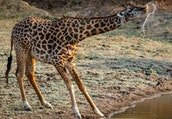- The Springbok is a medium-sized antelope with distinct physical features. Here is a description of its appearance:
- 1. Size and Build: Springboks have a slender and graceful build. They stand at about 70-90 centimeters (28-35 inches) at the shoulder and can weigh between 27-48 kilograms (60-105 pounds). Males are slightly larger and heavier than females.
- 2. Coat and Coloration: The Springbok's coat is short and smooth. The coloration varies depending on the region and season. Generally, their fur is light brown to reddish-brown on the upper body, with a white underbelly. The color of the coat helps them blend into their grassland habitat.
- 3. Facial Markings: One of the most recognizable features of the Springbok is its white face. The white coloration extends from the forehead to the snout, creating a striking contrast against the rest of its body. This distinct facial marking aids in species recognition.
- 4. Dark Side Stripe: Running along each side of the Springbok's body is a dark brown or blackish stripe. This stripe starts from the shoulder and tapers towards the rump. It adds to their camouflage and breaks up their outline, making it harder for predators to spot them.
- 5. Rump Patch: The Springbok has a white patch on its rump, which is usually concealed by the folded skin. However, when the animal leaps or pronks, the skin opens up, and the white patch becomes highly visible. This display is characteristic of Springboks and plays a role in social communication.
- 6. Horns: Both males and females have horns, but those of males are longer and thicker. The horns are lyre-shaped, curving backward and then slightly forward at the tips. They can reach lengths of around 35-50 centimeters (14-20 inches).
- Springboks are renowned for their incredible speed and agility. They are one of the fastest land animals, capable of reaching impressive speeds. Here's some information about the speed of Springboks: 1, Sprinting Speed: Springboks can sprint at remarkable speeds, clocking in at approximately 80 kilometers per hour (50 miles per hour). They can accelerate quickly and maintain these high speeds for short distances. 2, Agility: In addition to their speed, Springboks possess exceptional agility. They can make sudden changes in direction and execute quick turns while running at high speeds, enabling them to evade predators effectively. 3. Pronking: Pronking is a unique behavior exhibited by Springboks when they perform impressive leaps into the air. During pronking, Springboks arch their backs, lift all four hooves off the ground simultaneously, and hop in a graceful and bouncy manner. It is believed that this behavior is a display of strength, fitness, and communication among the herd. Pronking allows Springboks to demonstrate their vitality and agility, making them appear even more remarkable.
Africa Springbok:
The Springbok is a type of antelope native to Southern Africa, particularly found in South Africa, Namibia, and Botswana. It is also the national animal of South Africa and holds cultural and symbolic significance in the region.
Africa Safari Tour Book online The Springbok safari
The Springbok is a medium-sized antelope known for its distinctive appearance. The animal has a slender build with long legs and a light brown to reddish-brown coat. It features a characteristic white face, a dark stripe running down the sides, and a white patch on the rump, which is visible when the animal jumps or "pronks" in a distinctive behavior.
These antelopes inhabit a variety of habitats, including grasslands, savannas, and semi-desert areas. They are primarily grazers, feeding on grass and other vegetation. Springboks are well adapted to arid environments and can survive for long periods without water by obtaining moisture from their food.
During the mating season, male Springboks engage in territorial displays and impressive leaps called "pronking." These displays involve jumping high into the air with an arched back and raised tufts of hair on the rump. It is believed that these displays serve as a means of communication and to establish dominance among males.
Springboks are known for their remarkable speed and agility. They are among the fastest land animals, capable of reaching speeds up to 55 miles per hour (88 kilometers per hour). This swiftness helps them evade predators such as lions, cheetahs, and wild dogs.
In addition to their ecological importance, Springboks hold cultural significance in South Africa. They are closely associated with the country's national rugby team, which is known as the "Springboks." The team's name and emblem pay homage to the animal and its symbolism as a national icon.
Overall, the Springbok is a remarkable and iconic antelope species of Southern Africa, valued for its beauty, adaptability, and cultural significance.
1. Springboks Physical Description
2. Africa Springboks Speed:
Africa Springbok Safari Tour
An Africa Springbok safari tour offers a unique opportunity to witness one of Africa's most iconic antelope species, the Springbok (Antidorcas marsupialis). Springboks are known for their incredible speed, stunning leaping displays, and distinctive markings, making them a highlight of any safari experience.
By planning ahead and choosing reputable safari operators or guides, Springboks are graceful and charismatic animals, and observing them in the wild is a memorable experience. Remember to respect wildlife and follow the guidance of your safari guide to ensure a safe and enjoyable safari while minimizing any disturbance to the animals and their habitats. Enjoy the magic of Africa's wildlife and the diverse landscapes that make it a world-renowned safari destination.
Here are some key points to consider when planning an Africa Springbok safari tour:
Africa Springbok Safari Destinations
Safari Destinations: Springboks are native to the open plains and grasslands of Southern Africa. Some popular safari destinations where you may have a chance to see Springboks include:
- South Africa: Kruger National Park, Kgalagadi Transfrontier Park, Etosha National Park, and private game reserves in the Northern Cape and North West provinces.
- Namibia: Namib-Naukluft National Park, Etosha National Park, and private game reserves.
- Botswana: Chobe National Park, Makgadikgadi Pans National Park, and Moremi Game Reserve.
Africa Springbok Abundance
Abundance: Springboks are among the most abundant antelope species in Africa, and they are widespread across the regions mentioned above. This increases the likelihood of encountering them during your safari.
Africa Springbok Behavior
Behavior: Springboks are known for their "pronking" behavior, where they perform impressive leaps into the air, seemingly for no apparent reason. This behavior is believed to be a form of communication or a display of agility to predators.
Africa Springbok Mixed Herds
Mixed Herds: Springboks often form mixed herds with other herbivores, such as wildebeests, zebras, and gemsboks (oryx). These mixed herds can be a spectacle to witness during a safari.
Africa Springbok Conservation
Conservation: Although Springboks are not considered endangered, they are protected in national parks and game reserves. Responsible safari operators prioritize conservation efforts to preserve the species and their natural habitats.
Africa Springbok Game Drives and Guided Tours
Game Drives and Guided Tours: Participate in guided game drives or walking safaris led by experienced guides. They can help you spot Springboks and other wildlife, while also providing valuable insights into their behavior and ecology.
Africa Springbok Photography Opportunities
Photography Opportunities: Bring a camera with a zoom lens to capture wildlife sightings, including the impressive Springbok leaps and other captivating moments.
Africa Springbok Birdlife and Landscapes
Birdlife and Landscapes: During your Springbok safari, you will likely encounter a wide variety of other wildlife, including birds, mammals, and stunning landscapes, such as vast savannas and arid plains.








 |
|  |
|  |
|  |
| 